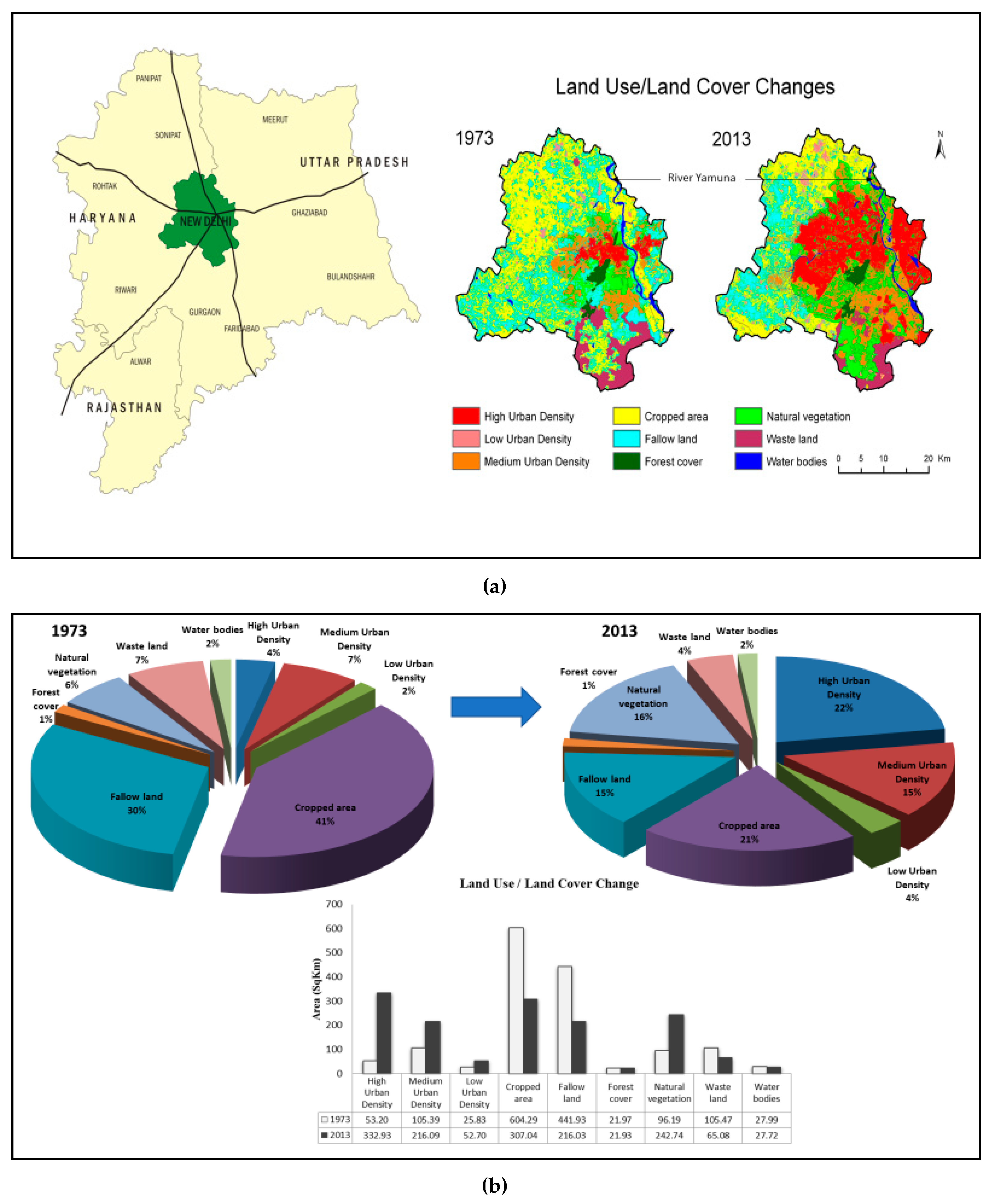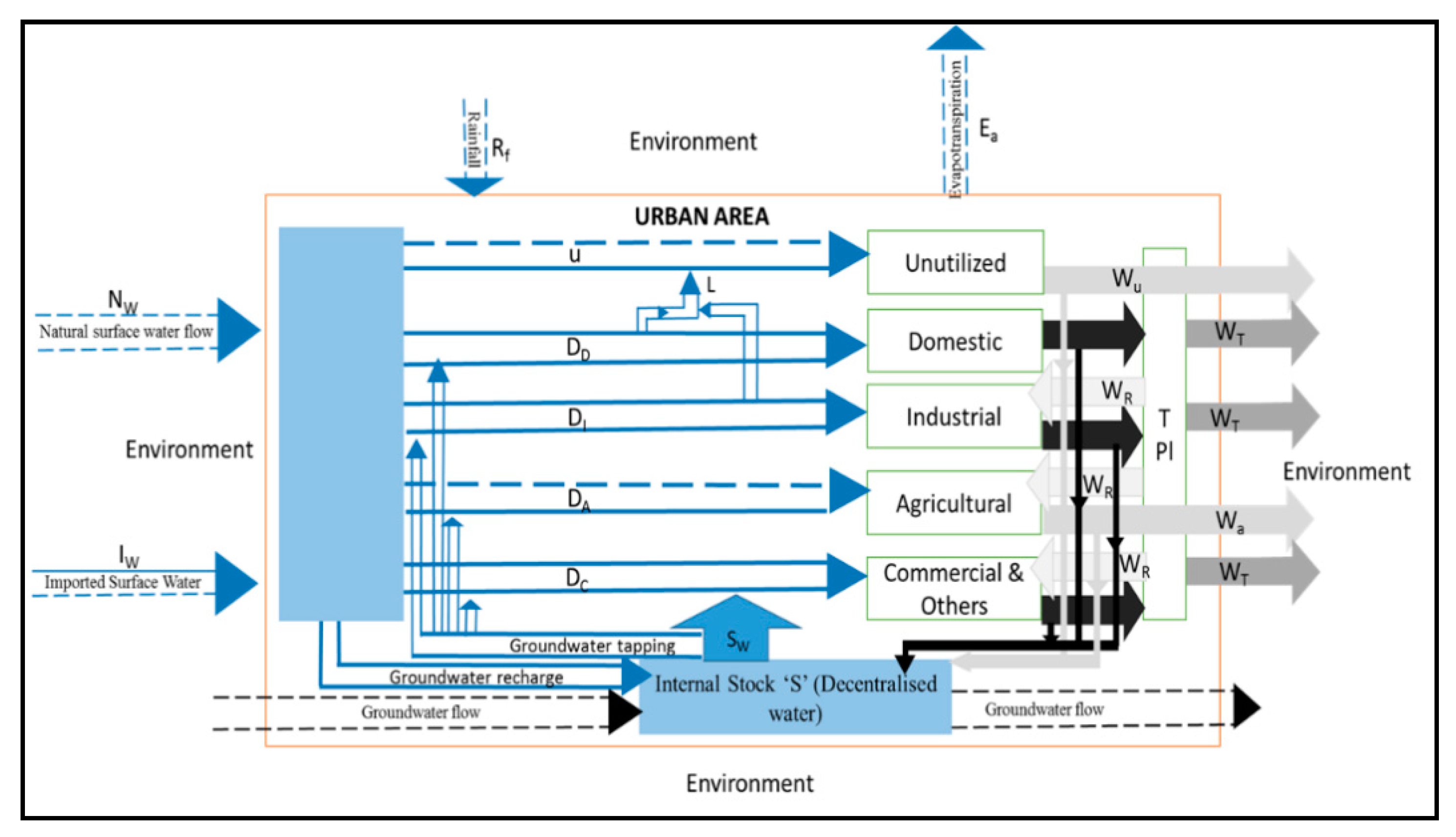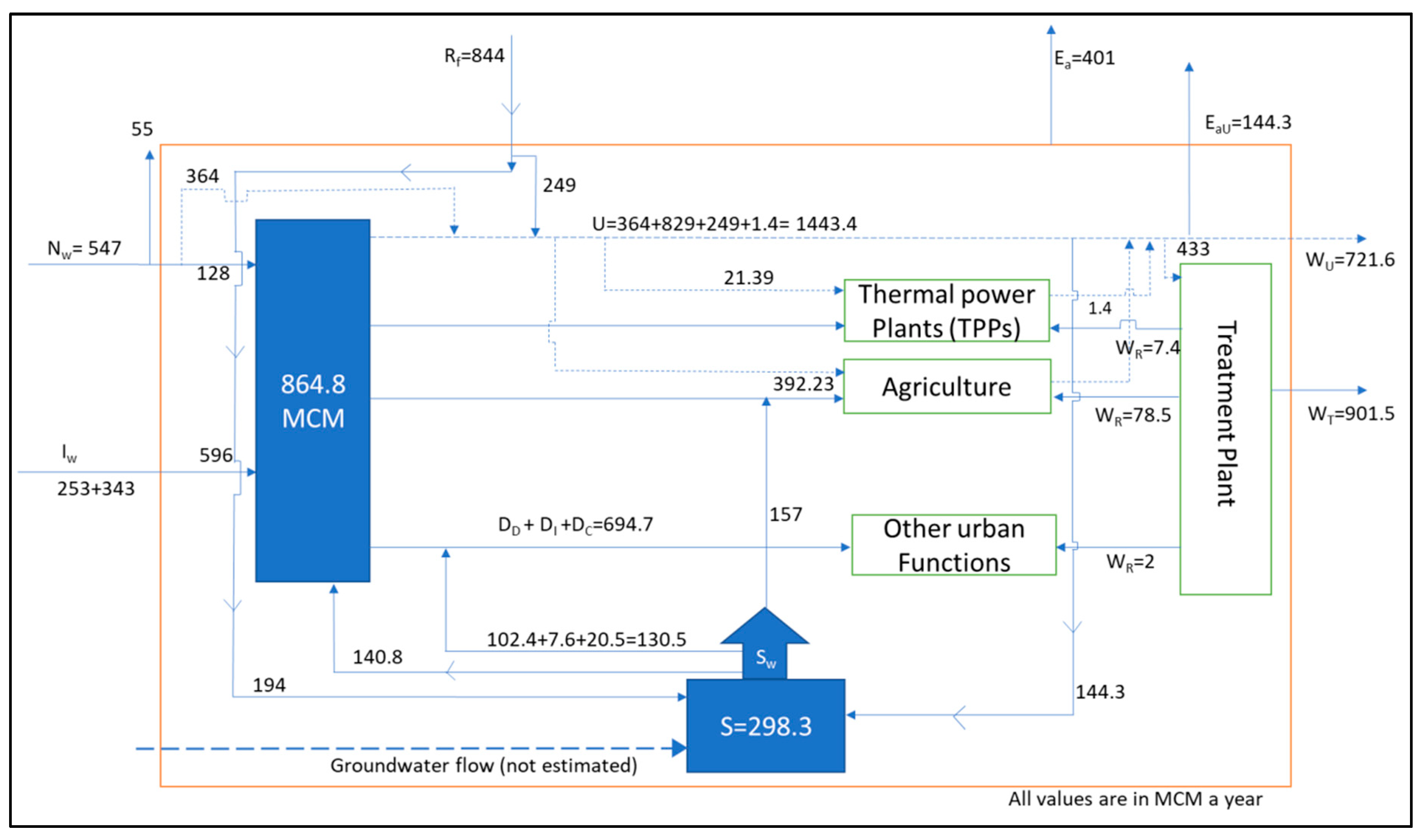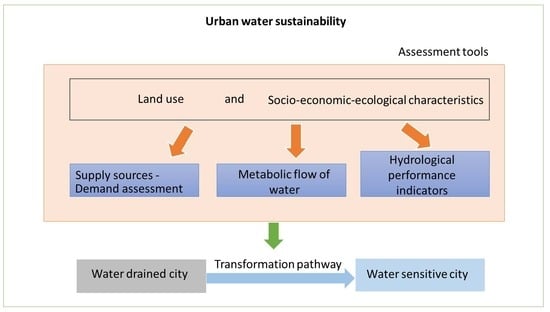Urban Water Security Assessment Using an Integrated Metabolism Approach—Case Study of the National Capital Territory of Delhi in India
Abstract
1. Introduction
Water Resource Characteristics of the Study Area
2. Methodology
2.1. Water Metabolism in Delhi—Modeling the Flows
2.2. Calculating Water Demand—Data Gathering for the Model
- Estimation of water demand from the consent-to-operate applications submitted by industries to the Delhi Pollution Control Committee (DPCC, a statutory environmental agency in Delhi).
- Assessment of water use through primary surveys in a sample of industries and extrapolating the data.
- Assessment from wastewater flows received by the Common Effluent Treatment Plants (CETPs).
2.3. Water Supply Sources
2.4. Urban Hydrological Performance Indicators
2.4.1. Water Use Intensity (WUI)
2.4.2. Overall Water Balance (OWB)
2.4.3. Supply Centralization (SC)
2.4.4. Rainfall Harvesting (RH)
2.4.5. Centralized Rainfall Supply Replaceability (CSR)
2.4.6. Total Rainfall Use Substitutability (TUR)
2.4.7. Wastewater Potential for Water Supply (TURw)
2.4.8. Turnover Rate
2.4.9. Water Budget
3. Results and Discussion
3.1. Water Demand in Delhi
- (a)
- Domestic water requirement constitutes nearly 74% of the total. The DJB’s norm for estimating the domestic requirements is 172 lpcd [9], whereas the real demand is estimated as 76 lpcd, on the basis of the current lifestyles of, and the use of water-related appliances by the residents of Delhi [16].
- (b)
- The estimate of industrial water demand is fraught with uncertainties. The industrial profile of Delhi has changed significantly over the past decade, and it is not clear whether the DJB has considered these changes.
3.2. Water Supply Potential
3.3. Water and Wastewater Flows Through the City
3.4. Hydrological Performance
3.5. Towards Water Sustainability
- Wastewater can be looked upon as a water resource, which can be utilized after proper treatment (as advocated by Alves [24] for Portugal and Opher [25] & Opher [26] for Israel)—it can meet 78.2% of the total needs. The use of groundwater can be discontinued altogether if even half the potential of wastewater is tapped.
- Stormwater has the potential to reduce the decentralized use of groundwater, if rainwater harvesting and artificial ponds can be created, and if water-permeable surfaces can be incorporated into the cityscape.
3.6. Summarizing the Results and Observations Made
- Decreasing the area under tillage
- Focus on less water-intensive crops
- Restructuring of the industry base over the last decade and a half, in favor of industries with smaller water footprints
- Early changes in lifestyle habits and better control over the use of water using white goods like washing machines and dishwashers
4. Conclusions and Recommendations
Author Contributions
Funding
Acknowledgments
Conflicts of Interest
References
- Andries, J.M.; Jansen, M.A.; Ostrom, E. A framework to analyse the robustness of social-ecological systems from an institutional perspective. Ecol. Soc. 2004, 9, 18. Available online: http://www.ecologyandsociety.org/vol9/iss1/art18/ (accessed on 11 June 2016). [CrossRef]
- Purkey, D.R.; Huber-Lee, A.; Yates, D.N.; Hanemann, M.; Herrod-Julius, S. Integrating a climate change assessment tool into stakeholder-driven water management decision-making processes in California. Water Resour. Manag. 2006, 21, 315–329. [Google Scholar] [CrossRef]
- Wong, T.H.; Brown, R.R. The water sensitive city: Principles for practice. Water Sci. Technol. 2009, 60, 673–682. [Google Scholar] [CrossRef] [PubMed]
- Behzadian, K.; Kapelan, Z.; Venkatesh, G.; Brattebø, H.; Sægrov, S.; Rozos, E.; Makropoulos, C.; Ugarelli, R.; Milina, J.; Hem, L. Urban water system metabolism assessment using watermet2 model. Procedia Eng. 2014, 70, 113–122. [Google Scholar] [CrossRef]
- Venkatesh, G.; Helge, B.; Sveinung, S. Dynamic metabolism modeling of urban water services-demonstrating effectiveness as a decision-support tool for Oslo, Norway. Water Res. 2014, 61, 19–33. [Google Scholar] [CrossRef] [PubMed]
- Zappone, M.; Fiore, S.; Genon, G.; Venkatesh, G.; Brattebø, H.; Meucci, L. Life-cycle energy and GHG emission within the turin metropolitan area urban water cycle. Procedia Eng. 2014, 89, 1382–1389. [Google Scholar] [CrossRef]
- Wolman, A. The metabolism of cities. Sci. Am. 1965, 213, 179–190. [Google Scholar] [CrossRef] [PubMed]
- Kenway, S.; Gregory, A.; McMahon, J. Urban water mass balance analysis. J. Ind. Ecol. 2011, 15, 693–706. [Google Scholar] [CrossRef]
- Government of National Capital Territory of Delhi (GNCTD). Economic Survey of Delhi 2014–15; Directorate of Economics & Statistics, GNCTD: Delhi, India, 2015. Available online: http://delhi.gov.in/wps/wcm/connect/DoIT_Planning/planning/economic+survey+of+dehli/economic+survey+of+delhi+2014+-+2015 (accessed on 12 September 2016).
- Bhagat, R.B. Emerging pattern of urbanisation in India. Econ. Political Wkly. 2011, 34, 10–12. Available online: http://suburbin.hypotheses.org/files/2011/09/RBBhagatUrbanisation.pdf (accessed on 17 July 2016).
- Sharma, D.; Kansal, A. Water quality analysis of River Yamuna using water quality index in the national capital territory, India (2000–2009). Appl. Water Sci. 2011, 1, 147–157. [Google Scholar] [CrossRef]
- DDA. Master Plan of Delhi-2021; Delhi Development Authority: Delhi, India, 2010; Available online: http://dda.org.in/ddanew/pdf/Planning/reprint%20mpd2021.pdf (accessed on 22 March 2019).
- GNCTD. State of Environment Report for Delhi. Chapter 2, Water Supply; Department of Environment and Forests, Government of India: New Delhi, India, 2010. Available online: http://www.indiaenvironmentportal.org.in/files/SoEDelhi2010.pdf (accessed on 22 March 2019).
- Central Ground Water Board (CGWB). Dynamic Ground Water Resources of India (As on 31st March 2011); Ministry of Water Resources, River Development & Ganga Rejuvenation, Government of India: Faridabad, India, 2014. Available online: http://www.cgwb.gov.in/documents/Dynamic-GW-Resources-2011.pdf (accessed on 29 September 2016).
- Ministry of Urban Development (MoUD). Functional Plan on Drainage for National Capital Region; National Capital Region Planning Board Ministry of Urban Development, Government of India: New Delhi, India, 2016. Available online: http://ncrpb.nic.in/pdf_files/FP%20on%20Drainage/Chapter%203%20-%20HYDROMETEROLOGY.pdf (accessed on 20 August 2016).
- Ghosh, R.; Kansal, A.; Aghi, S. Implications of end-user behaviour in response to deficiencies in water supply for electricity consumption—A case study of Delhi. J. Hydrol. 2016, 536, 400–408. [Google Scholar] [CrossRef]
- Central Electricity Authority (CEA). Report on Minimisation of Water Requirement in Coal Based Thermal Power Stations; Central Electricity Authority: New Delhi, India, 2012. Available online: http://cea.nic.in/reports/others/thermal/tetd/min_of%20water_coal_power.pdf (accessed on 29 September 2016).
- FICCI. Water Use and Efficiency in Thermal Power Plants; Federation of Indian Chambers of Commerce & Industry and HSBC Knowledge Initiative Federation House: New Delhi, India, 2010; Available online: http://ficci.in/spdocument/20147/ficci-water-use.pdf (accessed on 29 September 2016).
- Soni, V. Water and carrying capacity of a city—Delhi. Econ. Political Wkly. 2003, 38, 4745–4749. [Google Scholar]
- Central Public Health and Environmental Engineering Organization (CPHEEO). Manual on Sewerage and Sewage Treatment, Part A: Engineering; Ministry of Urban Development, New Delhi in Collaboration with Japan International Cooperation Agency, Japan: India, 2012. Available online: http://www.cmamp.com/CP/FDocument/ManualonSewerageTreatment.pdf (accessed on 17 July 2016).
- Central Pollution Control (CPCB). Board Report 2007–2008; Status of Groundwater Quality in India Part–II; Central Pollution Control Board: Delhi, India, 2008; Available online: http://www.cpcb.nic.in/upload/NewItems/NewItem_50_notification.pdf (accessed on 17 July 2016).
- Ramos, G.C.D. Water and political ecology of urban metabolism: The case of Mexico city. J. Political Ecol. 2015, 22, 98–114. [Google Scholar] [CrossRef]
- Census of India 2011. Office of The Registrar General and Census Commissioner Government of India. Available online: http://www.censusindia.gov.in/2011census/population_enumeration.html (accessed on 17 July 2016).
- Alves, D.; Monte, H.M.D.; Albuquerque, A. Water Reuse Projects—Technical and Economic Sustainability; Official Publication of the European Water Association (EWA), E-Water: Portugal, 2011. [Google Scholar]
- Opher, T.; Shapira, A.; Friedler, E. A comparative social life cycle assessment of urban domestic water reuse alternatives. Int. J. Life Cycle Assess. 2017, 23, 1315–1330. [Google Scholar] [CrossRef]
- Opher, T.; Friedler, E.; Shapira, A. Comparative life cycle sustainability assessment of urban water reuse at various centralization scales. Int. J. Life Cycle Assess. 2018, 1–14. [Google Scholar] [CrossRef]
- Musango, J.K.; Currie, P.; Robinson, B. Urban Metabolism for Resource Efficient Cities: From Theory to Implementation; UN Environment: Paris, France, 2017. [Google Scholar]
- Angelakis, A.N.; Synder, S.A. Wastewater treatment and reuse: Past, present, and future. Water 2015, 7, 4887–4895. [Google Scholar] [CrossRef]



| Month | Jan | Feb | Mar | Apr | May | June | July | Aug | Sept | Oct | Nov | Dec | Total |
|---|---|---|---|---|---|---|---|---|---|---|---|---|---|
| Rainfall (mm) | 14.9 | 13.1 | 8.9 | 6.7 | 12.0 | 44.0 | 177 | 181 | 93.5 | 7.8 | 4.9 | 5.0 | 568.8 |
| Rainy days | 1.2 | 1 | 0.8 | 0.5 | 0.8 | 2.1 | 7.4 | 7.9 | 4.0 | 0.8 | 0.1 | 0.4 | 27 |
| Evaporation (mm/d) | 4.5 | 5.2 | 6.4 | 7.9 | 8.6 | 6.6 | 8.1 | 5.8 | 6.3 | 6.7 | 5.8 | 4.7 | — |
| Sector | Quantity (Million Cubic meters /year) | Remarks |
|---|---|---|
| Domestic (DD) | 465.7 | Based on sample survey. Real demand instead of water supplied. |
| Industrial (DI) | 23.7 | Modeled data. Inadequate and uncertain information about industrial units in Delhi. |
| Thermal power plants | 21.4 | Modeled data. |
| Agriculture (DA) | 392.2 | Modeled data. |
| Commercial and others (DC) | 114.6 | Reported value. Two-year-old data. |
| Total | 1017.6 | — |
| Month | Rainfall (mm) | Rainy Days (>2.5 mm) | Potential Rate (cm/day) | Evaporation Loss (mm) | Balance (mm) |
|---|---|---|---|---|---|
| July | 177 | 4 | 0.57 | 111 | 66 |
| August | 181 | 5 | 0.41 | 84 | 97 |
| September | 94 | 2 | 0.44 | 75 | 19 |
| Total | 452 | 11 | 270 | 182 |
| Indicators | Units | Values |
|---|---|---|
| Water use intensity (WUI) | MCM/km2/year | 0.732 |
| Overall water balance (OWB) | % | 136.7 |
| Supply centralization (SC) | % | 66.9 |
| Rainwater harvesting (RH) | % | 50.7 |
| Centralized rainfall supply replaceability (CSR) | % | 97.6 |
| Total rainfall use replaceability (TUR) | % | 65.3 |
| Wastewater potential for water supply (TURw) | % | 78.2 |
| Anthropogenic turnover rate (ATR) | Number of times per year | 5.08 |
| Rainfall turnover rate (RTR) | Number of times per year | 2.83 |
| Overall turnover rate (OTR) | Number of times per year | 7.91 |
| Change in stock (∆S) | MCM/year | −236 |
© 2019 by the authors. Licensee MDPI, Basel, Switzerland. This article is an open access article distributed under the terms and conditions of the Creative Commons Attribution (CC BY) license (http://creativecommons.org/licenses/by/4.0/).
Share and Cite
Ghosh, R.; Kansal, A.; Venkatesh, G. Urban Water Security Assessment Using an Integrated Metabolism Approach—Case Study of the National Capital Territory of Delhi in India. Resources 2019, 8, 62. https://doi.org/10.3390/resources8020062
Ghosh R, Kansal A, Venkatesh G. Urban Water Security Assessment Using an Integrated Metabolism Approach—Case Study of the National Capital Territory of Delhi in India. Resources. 2019; 8(2):62. https://doi.org/10.3390/resources8020062
Chicago/Turabian StyleGhosh, Ruchira, Arun Kansal, and G Venkatesh. 2019. "Urban Water Security Assessment Using an Integrated Metabolism Approach—Case Study of the National Capital Territory of Delhi in India" Resources 8, no. 2: 62. https://doi.org/10.3390/resources8020062
APA StyleGhosh, R., Kansal, A., & Venkatesh, G. (2019). Urban Water Security Assessment Using an Integrated Metabolism Approach—Case Study of the National Capital Territory of Delhi in India. Resources, 8(2), 62. https://doi.org/10.3390/resources8020062







